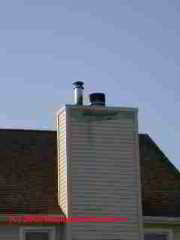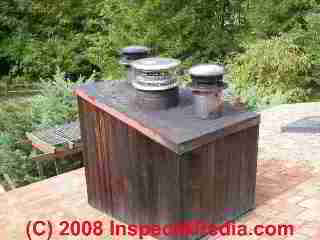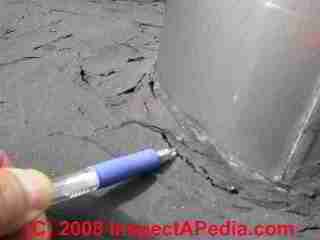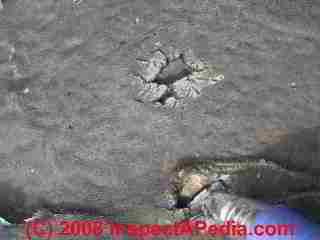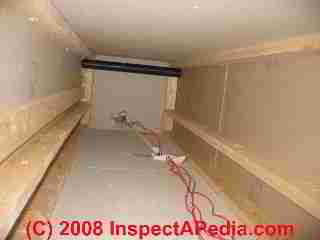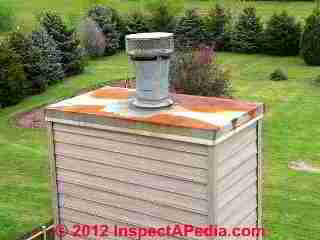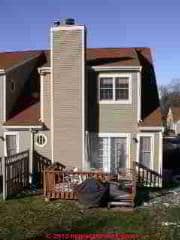 Build / Inspect / Repair a Chimney Chase
Build / Inspect / Repair a Chimney Chase
- POST a QUESTION or COMMENT about wood-framed metal chimney enclosures, construction, safety, repair, demolition, replacement
How to build, inspect or repair a wood-framed chimney chase.
This article describes wood-enclosed metal chimneys, how a chimney chase should be constructed, and how those structures can be inspected for leaks, damage, or unsafe conditions.
This article describes how to perform a visual inspection of wood framed chimney chases used to enclose factory-built metal chimneys for safety and other defects. Chimney inspection methods and chimney repair methods are also discussed.
InspectAPedia tolerates no conflicts of interest. We have no relationship with advertisers, products, or services discussed at this website.
- Daniel Friedman, Publisher/Editor/Author - See WHO ARE WE?
Wood Framed Chimney Chases around Metal & Insulated Metal Chimneys & Flues
Chimney Chase Construction SNAFUs to Avoid
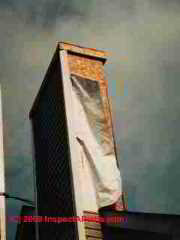
Our photographs show a typical wood-framed chimney chase constructed to house an insulated metal chimney and/or a Type-B gas vent.
Our photo above shows vinyl siding has fallen off of the chimney chase, permitting leaks into the structure.
Below we show common leaky conditions at the top of a wood-framed chimney enclosure.
The photo below shows an incomplete chimney chase with poor workmanship - incomplete installation of housewrap, missing chimney flashing, and who knows what at the chimney top.
...
The most common defect we find at wood-framed chimney chase ways is an improperly-constructed top flashing that is not sloped to drain properly (shown below).
Often people try to fix a leak at the the chimney top by smearing on roofing mastic (above right). We find that this is not a durable repair.
A close-look at the top of a mastic-coated wood-framed chimney chase may show that the top is still concave, sloping in towards the chimneys and that the combination of heat and sunlight has dried and cracked the sealant. (Photos above and below).
...
Because the top of chimneys is not readily accessible, leaks in this location may remain undiagnosed for too long, risking insect damage, rot, and mold in the structure below.
The result is leaks inside of the chimney chaseway where water may lead to a damaged and unsafe fireplace insert or heating appliance, rot, and insect damage.
Our photo (left) shows how the interior of a wood-framed chimney chaseway may be constructed using common framing lumber and drywall. In this particular chase no chimney has (yet) been installed.
But leaks at the top of this structure wet the drywall sides leading to a (hard to see) mold contamination.
How to Build a Wood-Framed Chimney Chase
Watch out: before buying materials and starting to hammer away at constructing a chimney chase for your home, be sure to check with your local building code officials.
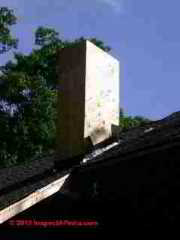 A building permit is required in most jurisdictions, and the applicable building codes and inspections are important fire safety checks on your chimney chase design and construction.
A building permit is required in most jurisdictions, and the applicable building codes and inspections are important fire safety checks on your chimney chase design and construction.
Common Specifications & Construction Details for a Wood-Framed Chimney Chase
- Dimensions for a wood framed chimney chase
may be as small as 24" deep x 36" wide, but are more typically 3ft x 5ft x the necessary height to meet roof clearance requirements. Some builders frame the entire chase, beginning inside the structure (where for example a zero-clearance fireplace is to be installed) as wide as six feet to accommodate the fireplace insertion and to support a mantle.
At our References or Citations section you will find referrals to chimney construction & fire building codes. Framing nailing and structure is typically the same as structural wood framed wall construction in dimensions and spacing of framing members.
Also see FIRE CLEARANCES, METAL CHIMNEYS.
Properly framed and constructed, the portion of the chimney chase that extends above the roof surface at a height to meet the roof clearance distances will not require extra bracing. - Framing the chimney chase:
typically uses 2x4 structural members sheathed with OSB or plywood exterior building sheathing.
For wind resistance, if the chimney chase is passing through the roof structure (rather than abutting the roof structure end, it should be framed continuously through the roof structure, not simply tacked on top of the roof sheathing.
Take a look at the photo above showing the inside of a wood-framed chimney chase.
Watch out: the chimney chase support at its base must be able to accommodate the weight of not only the structure and the chimney that may be routed through it (and its supporting brackets) but also the exterior siding (or stone) that may be applied. Extra supporting beams, headers, or a footing may be needed. - A chimney chase cricket
is recommended between the chimney side facing the roof and the roof surface,
otherwise you're asking for leaks in this location. In some jurisdictions (check with your local code officials) builders leave a one-inch space (see local and model building codes such as IRC code R1001.17) between the cricket edges and the chimney chase vertical side and similarly between the cricket and the roof deck. - Assembly of the chimney chase:
some builders construct the wood-frame of the chimney chase on the ground,
perhaps in two sections depending on overall chimney height. By capping each section with solid plywood at each floor height, fire stopping has been added.
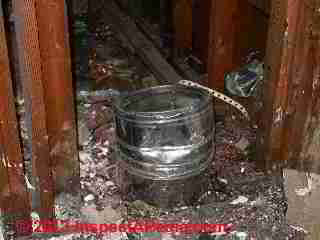
Our photo (left) shows the remains of a metal chimney passing through the framed chimney chase enclosure as it passed through the first floor of occupied space in a building that suffered severe damage from a chimney chase fire. The factory-built insulated metal chimney was venting an oil fired heating boiler.
- Chimney chase fire blocking requirements:
fire-blocking (perhaps 3/4" thick plywood or OSB (fire rated?)
is intended to slow or even prevent the movement of a chimney chase fire between building floors, and to prevent the increase of fire intensity and spread by the chimney effects that would occur inside the chimney chase without fires topping.
Fire stopping installed in a wood framed chimney chaseway must comply with local codes
Also see IRC 602.8. Fire blocking is also referred to as fire stopping or "fire stops". Factory-built metal fire block shields may be required by and provided by the manufacturer of the metal chimney to be installed through the chimney chase.
At CHIMNEY SHROUD FIRE we describe and illustrate serious fire damage caused by an unsafe and unlisted chimney top decorative shroud installed on a home in Moorpark CA. - Chimney chase insulation
is not normally used; the fire rating and fire safety of the chimney will depend on proper selection and installation of the insulated metal flue that will pass through the structure.
If for some reason you are insulating a chimney chase be sure that your insulation is kept back from the metal chimney itself in accordance with its instructions and fire codes. - Securing the chimney chase
The chimney chase must be adequately secured to the building to withstand storms and wind loads for your area.
Builders use steel framing connectors such as Simpson Strong-Ties™ to secure the vertical framing of the chimney chase to the building structural wall. Connecting the chimney chase sheathing to the building framing adds stiffness and support. - Sealing the chimney chase
against leaks: we find a lot of leaks into wood framed chimney chases, including at
How to Identify Common Leak points & Hazards at Wood Framed Chimney Chases
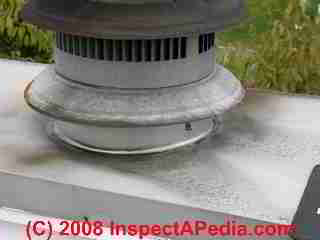
- The chimney chase top, (chimney chase cover) is usually metal, constructed of formed aluminum or stainless steel.
We find leaks here especially where the top is framed and enclosed "flat" and the top flashing lacks adequate pitch and stiffness to avoid collapsing, even becoming concave" where there are snow loads. (See our chimney chase top photo at left). - At the flashing between the chimney chase box and the roof and roof cricket
these leaks are almost always because someone was not careful to follow normal roof -to-chimney flashing detailing about flashing size, using step flashing and counter flashing. Do not rely on roof sealants and mastics instead of proper flashing. - Through the chimney chase final covering:
especially if faux stone or brick are used, but also if vinyl siding or other siding is not properly installed and sealed.
Builders installing a stone or brick veneer often cover the entire chimney chase exterior with a stick-on flashing membrane such as WR Grace Ice and Water Shield. - Watch out: for animals entering the chimney chase.
A bird or squirrel nesting in the chimney chase is likely to create a fire hazard.
Building owners or maintenance staff (such as at condominium complexes where many wood framed chimney chases may be installed) should inspect for evidence of squirrel-chewed openings in the chase sides, lost or open combustion air screens, and blown-off siding or chimney top seals.
How to Replace a Defective Chimney Chase Pan & Installing a Listed Decorative Chimney Top Shroud
Details of this topic have been moved to a new article found
at CHIMNEY SHROUDS. Excerpts are just below.
A "Chimney Crown" as popularly used in the fireplace industry may refer to a decorative top shroud installed atop a wood-framed chimney chase, as illustrated here.
Steve Werner, a home inspector and chimney shroud installer with Chimney King [6], a custom chimney "crown" designer in Gurnee IL, provided us with the following wood framed chimney chase top pans along with comments.
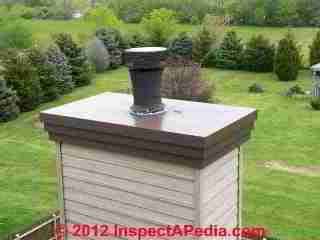
In the photo at above left, the top of the chimney chase was too small to allow for a decorative shroud to function safely according to our UL/OMNI test labs certification.
We designed what we call a ‘super chase pan’ to increase the size of the top of the chase so a legal labeled shroud could be placed on top.
At above right we can see the newly fabricated chimney chase top pan that has been corbeled out to increase its footprint or horizontal size dimensions to accommodate a decorative top shroud.
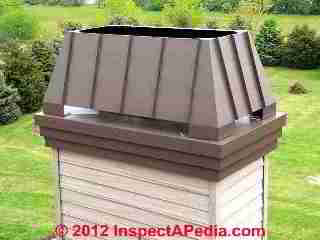
Mr. Werner continues:
In the fireplace industry we use the term “chase pans” for the covering at the top of a wood framed chimney chase.
Our company, ChimneyKing, has bought lots of fireplaces, pipe, and made many decorative shrouds for testing in these labs to assure that our products are labeled and safe.

- Contributor & technical review: Stephen Werner General Manager Chimney King, LLC P.O. Box 8 Gurnee, IL 60031 Corporate (847) 244-8860 Fax (847) 244-8694 Email: steve@chimneyking.com
- [5]Stephen Werner, General Manager, Chimney King LLC [website], P.O. Box 8, Gurnee, IL 60031, Tel: (847) 244-8860, Email: steve@chimneyking.com, Website: www.chimneyking.com .
Mr. Werner is also a licensed home inspector serving clients in Wisconsin. Chimney King sells their products through a network of fireplace dealers, chimney sweeps, roofers and builders. Each decorative shroud is custom built because no two chimneys/chases are exactly alike. - Stephen Werner, General Manager Chimney King, op cit, personal communication 3/26/2013 w/attachments:
- CHIMNEY KING INSTALLATION INSTRUCTIONS FOR CHIMNEY CROWN, [PDF]
- Purdie, Roger K., CHIMNEY FIRE SAFETY BULLETIN [PDF] Vista Fire Protection District, 2001, report of house fire related to the home's metal chimney. Contains advice for chimney fire safety & sketches of approved and not-code-approved metal chimney tops, caps & crowns.
- See also CHIMNEY SHROUD FIRE [Web page] technical article contribution by Mr. Werner
Chimney Construction Research & References
- [33] Chimney Safety Institute of America - Chimney Fires: Causes, Effects, Evaluation
- [34] National Chimney Sweep Guild - Yellow Pages of Suppliers
- [35] BUILDING CODES THAT REGULATE DECORATIVE CHIMNEY SHROUDS [PDF] provided by Stephen Werner [5], cites:
- International Mechanical Code IMC (2000), M74-98 806.6, ratified 9.98, model building code for the United States,
806.6 Decorative Shrouds. Decorative shrouds shall not be installed at the termination of factory-built chimneys, except where such shrouds are listed and labeled for use with the specific factory-built chimney system and are installed in accordance with section 304.1.
Reason: Decorative shrouds have been the cause of roof and chase fires - International Residential Code (IRC) (2000), R1002.2 ratified 9/99, 1000.2
Decorative Shrouds. Decorative shrouds shall not be installed at the termination of factory-built chimneys, except where such shrouds are listed and labeled for use with the specific factory-built chimney system and are installed in accordance with the manufacturers installation instructions.
Reason: Decorative shrouds often allow for the creation of temperatures in excess of those permitted in UL 103 and UL 127. Decorative shrouds have been the cause of chase top fires ... - International Fire Code (IFC) (2000), IFC 603.6.3, 603.6.3 Decorative Shrouds.
Decorative shrouds installed at the termination of factory-built chimneys shall be removed, except where such shrouds are listed and labeled for use with the specific factory-built chimney system and are installed in accordance with the manufacturers installation instructions. r
eason: Decorative shrouds have been the cause of dozens of chase fires. As a non-listed part to a listed assembly, their use should not have been allowed in the first place.
- International Mechanical Code IMC (2000), M74-98 806.6, ratified 9.98, model building code for the United States,

- [36] International Residential Code IRC R100.11 - Fireplace Clearance:
International Residential Code was recently amended:
R1001.11 Fireplace clearance. Combustible material shall have a clearance of not less than 2 inches (51 mm) from the front faces and sides of masonry fireplaces and not less than 4 inches (102 mm) from the back faces of masonry fireplaces. The air space shall not be filled, except to provide fire blocking in accordance with Section R1003.12.
Exceptions:1. Masonry fireplaces listed and labeled for use in contact with combustibles in accordance with UL 127, and installed in accordance with the manufacturer's installation instructions, are permitted to have combustible material in contact with their exterior surfaces.
2. Combustible materials, including framing, wood siding, flooring and trim, shall be permitted to abut the sides and hearth extensions, but not the backs, of masonry fireplaces, in accordance with FIGURE R1003.12, provided such combustible materials are a minimum of 12 inches (306 mm) from the inside surface of the nearest firebox lining.
3. Exposed combustible mantels or trim may be placed directly on the masonry fireplace front surrounding the fireplace opening provided such combustible materials shall not be placed within 6 inches (153 mm) of a fireplace opening.
Combustible material within 12 inches (305 mm) of the fireplace opening shall not project more than 1/8 inch (3.2 mm) for each 1-inch (25 mm) distance from such opening. - [19] "Chimney Inspection Procedures & Codes," Donald V. Cohen was to be published in the first volume of the 1994 ASHI Technical Journal by D. Friedman, then editor/publisher of that publication.
The production of the ASHI Technical Journal and future editions was cancelled by ASHI President Patrick Porzio. Some of the content of Mr. Cohen's original submission has been included in this more complete chimney inspection
article series: CHIMNEY INSPECTION DIAGNOSIS REPAIR . Copies of earlier editions of the ASHI Technical Journal might be available from ASHI, the American Society of Home Inspectors. - See also our additional citations at the bottom of this page
...
Reader Comments, Questions & Answers About The Article Above
Below you will find questions and answers previously posted on this page at its page bottom reader comment box.
Reader Q&A - also see RECOMMENDED ARTICLES & FAQs
On 2021-09-30 by inspectapedia.com.moderator (mod) - replace a pre-fab chimney run inside of a chimney chase
@Mark Dietrich,
If the existing metal chimney is secured at various points inside the chimney Chase then you will need to gain access to those locations in order to remove it and replace it.
You'll want to check the manufacturer's installation instructions for your new chimney to see the support requirements for the new product as that may be different.
On 2021-09-30 by Mark Dietrich
I need to replace a prefab chimney pipe.
How to I remove the old steal flue pipe? Is straped to the walls of the chimney chase?
Are just a matter of pulling the old pipe out?
Thanks
On 2021-09-17 by inspectapedia.com.moderator (mod) - levels of chimney inspection: Define Level 1, 2, 3
@Jim,
We're glad to be of help and hope you'll keep us posted, perhaps posting also some photos of the existing chimney chase and details about the fire as that may help keep other readers safe.
On 2021-09-17 by Jim
@inspectapedia.com.moderator,
Thanks for your help,
Jim
On 2021-09-16 by inspectapedia.com.moderator (mod) - rafter a fire: equired access points into chimney chase for level 1, level 2, level 3 chimney inspections
@Jim,
Thank you for that added detail;
Depending on the chimney height and construction, an access door, for example close to ground level, is not going to give view of the condition of the entire chimney exterior (running in the chaseway) because the chimney chase may be separated into segments by fire blocking.
Be sure that you discuss this limitation with your chimney sweep.
The entire chimney flue interior can, of course, be inspected by a chim-scan type camera.
It is also important to understand the cause of the chimney fire that already occurred, in particular in a COA where there may be common building materials, methods, installations of heating equipment, and even maintenance (by the same company and even technician) - look for those condtions in other occupancies, heating equipment, not just at the chimneys.
For other readers, as the CSIA notes,
Definition of 3 Levels of Chimmey Safety Inspection & What's Included
Define: Level 1 chimney inspection,
your chimney service technician should examine the readily accessible** portions of the chimney exterior, interior and accessible* portions of the appliance and the chimney connection.
Your technician will be looking for the basic soundness of the chimney structure and flue as well as the basic appliance installation and connections. The technician will also verify the chimney is free of obstruction and combustible deposits.
A Level 2 inspection is required
when any changes are made to the system. Changes can include a change in the fuel type, changes to the shape of, or material in, the flue (i.e. relining), or the replacement or addition of an appliance of a dissimilar type, input rating or efficiency.
Additionally, a Level 2 inspection is required upon the sale or transfer of a property or after an operation malfunction or external event that is likely to have caused damage to the chimney. Building fires, chimney fires, seismic events as well as weather events are all indicators that this level of inspection is warranted.
There are no specialty tools (i.e. demolition equipment) required to open doors, panels or coverings in performing a Level 2 inspection.
A Level 2 inspection shall also include a visual inspection by video scanning or other means in order to examine the internal surfaces and joints of all flue liners incorporated within the chimney. No removal or destruction of permanently attached portions of the chimney or building structure or finish shall be required by a Level 2 inspection.
When a Level 1 or Level 2 inspection suggests a hidden hazard and the evaluation cannot be performed without special tools to access concealed areas of the chimney or flue, a Level 3 inspection is recommended.
A Level 3 chimney inspection
addresses the proper construction and the condition of concealed portions of the chimney structure and the flue
to which we have added, it may be necessary to make more than one access openings to gain view of all portions of the chimney chase interior and chimney exterior within the chaseway.
A Level 3 inspection addresses the proper construction and the condition of concealed portions of the chimney structure and the flue
to which we have added, it may be necessary to make more than one access openings to gain view of all portions of the chimney chase interior and chimney exterior within the chaseway.
- CSIA, Chimney Safety Institute of America, 2155 Commercial Drive, Plainfield, IN 46168 USA, Tel: (317) 837-5362 Email: office@csia.org Web: https://www.csia.org/inspections.html
Also see the
- National Chimney Sweeps Guild that certifies chimney sweeps, 1255 SW Prairie Trail Pkwy, Ankeny, Iowa 50023 USA Tel: +1 (317) 837-1500 Email: office@ncsg.org Web: https://www.ncsg.org/
On 2021-09-15 4 by Jim
@inspectapedia.com.moderator,
Hi,
Thanks for your reply. We had a fire in one of our buildings. The cause was undetermined and listed as accidental. We want to install access doors so our chimney sweep can do a Level III inspection on the remaining chase of the building. We have Level II inspections done every other year and we would like to have a Level III inspection done.
Thanks,
Jim
On 2021-09-13 by inspectapedia.com.moderator (mod) - We can't find an off-the-shelf fire rated exterior door that has stainless steel hinges
@Jim,
I'm not certain that I have the correct understanding of your project, but
If you are making an opening in a wood chimney chase like those discussed here, you are not accessing the actual chimney itself, just the wood enclosure to it.
If that's the case,
as long as your access opening is weatherproof (so you won't damage the chimney chase by leaks and thus make it unsafe),
and provided your opening cutout doesn't harm the structural components of the chimney chase
and provided your opening cutout does not subvert any fire-blocking that may have been required in the chimney chase
I would expect you could make a weatherproof door out of the same materials used construct the chase itself,
and that your local building or fire inspector will approve it.
There are also available pre-fab access panel frames and doors of various sizes made for indoor or outdoor use and that can be built into the chimney chase frame.
Why are we making this chimney chase opening?
See details of chimney access or cleanout doors
On 2021-09-13 by Jim
Hi, regarding chimney chases at our ski mountain COA, we are looking to install exterior access doors on the chases. Can you tell me if the access doors need to be fire rated? We are looking at a non-fire rated stainless steel door with stainless steel hinges.
We can't find an off-the-shelf fire rated exterior door that has stainless steel hinges that will not rust. Our COA is in Vermont.
Thanks,
On 2021-05-31 by mak.church (mod) - articles on chimney installation for a "buck stove"
@leddyhonda00, For this change in your plans, I would refer you to the following articles:
1) Readers Q&A Section (specifically the numerous Tatyana exchanges) https://inspectapedia.com/chimneys/Chimney-Re-Lining-Repairs.php#QA
2) Convert Zero Clearance Fireplace to Woodstove Safe installation of ... https://inspectapedia.com/chimneys/Woodstove_Installation.php
3) Fire Clearances for Woodstoves, Pellet Stoves, Coal stoves. Heat ... https://inspectapedia.com/chimneys/Woodstove_Fire_Clearance_Codes.php
Let us know if you have additional questions.
On 2021-05-30 by leddyhonda00
@inspectapedia.com.moderator, @Leddyhonda00@gmail.com,
I rethought my plan and will just be doing a zero clearence buckstove unit. Still installed is the 10" flue pipe as well as 14" surrounding the 10" all the way to the top.
The buck stove calls for 103ht rated6" stove pipe. Could i use 6" flex liner instead and drop it into the existing flue piping.
On 2021-05-30 by inspectapedia.com.moderator (mod) - how to make the chimney chase fire resistant
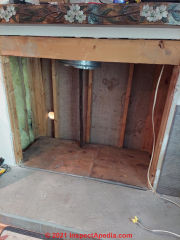 @Leddyhonda00@gmail.com,
@Leddyhonda00@gmail.com,
Sorry Leddy but because the risk that you could burn down the house and burn up its occupants by making a mistake, I cannot advise that you think you can, without an on-site expert, make that old fireplace insert area fire-safe for an arbitrary installation of some unknown heater in the future.
More often the installer will read the zero-cleareance fireplace installation instructions with care to see its dimensions and the required clearance to combustibles for that specific heater.
You don't want to simply start adding "fireproof" materials to the existing opening before knowing what's going into it, or your new appliance may simply no longer fit.
A free-standing woodstove can become enormously hotter than your old fireplace insert and has different fire-clearance requirements than a zero-clearnce fireplace insert - for example, typically three feet from the woodstove to any combustible materials.
You would have to either use a fire-inspector-approved heat shield or remove all of the combustible materials in the area completely.
Also
Watch out: there is no assurance that that metal chinmney (of which we see only a tiny bit of an extension) is fire-safe and rated for use with your woodstove.
To install a woodstove in most jurisdictions you need a building permit and work must be done to local fire-code specs.
On 2021-05-30 by Leddyhonda00@gmail.com
I have a wood framed fireplace chase. I just pulled out an old zero clearence wood fireplace and want to make the chase non combustible. Any reccomendations with this process? I want to install a free standing woodstove
On 2021-03-22 by danjoefriedman (mod) - masonry fireplace chimney is sinking, can I replace it with a wood framed chase & metal flue?
@george k michaels, sure.
On 2021-03-22 by george k michaels
my email is gjltg66@yahoo.com----have a heatalator wood burning fireplace with a masonary chimney--chimney is sinking and pulling away from the house--
can i remove the masonary chimney and replace it with a wood framed chimney with a double or triple flue--as i said it is a wood burning fireplace--thank you
On 2020-05-10- by (mod) - how to remove a wood chimney chase surrounding a metal chimney
Jerry,
Before offering an opinion I'd need to understand what problem we are solving, and what construction is present.
On 2020-05-10 by jerry
how to remove wood chases from house prefab chimney
On 2019-07-22 - by (mod) - raccoon got into our chimney chase
Yes I'd open the chase from outside to remove the dead raccoon; else you'll live with a smell and possibly a health concern. Since some raccoons carry rabies you need to assure the dead animal is remove taking proper precautions.
I'd study the fireplace and chimney plans and take a few measurements to cut a sufficiently large access opening in the outer face of the chimney chase to give adequate access; enlarge it if necessary; you can finish the job by building a trimmed removable panel to cover the cutout opening.
Post some photos of the chimney chase (one photo per comment) and of what you find inside and I can comment further.
More about raccoons in buildings is at
RACCOONS in the ATTIC
On 2019-07-21 by John D.
We have a plywood framed wood chimney chase that is sheathed with shiplap.
A raccoon got into the top of the chase through the cricket connection to the chase and apparently worked its way into the chase proper. I heard it fall down the chimeny and land on the fire box.
We've heard some movement, but that stopped quickly and it looks like it died. How would you recommend we open up the side of the chasse to get at the animal to either let it out or remove the carxass?
On 2019-07-12 by Chase cover over faux stucco
Hello,
Would you be able to tell me if we need to put a stainless steel chase cover over our chimney, which was recently redone using a faux stucco material? We had a chimney service come out for an estimate, but they said we do not need a chase cover (due to the faux material).
I am worried that down the line, this will be a problem. Thank you.
On 2018-11-11 - by (mod) - where to find the leak at a wood framed chimney or chimney top
Anon
I would check the obvious and the common leak points such as a bad Chimney Cap, a bad top sealer shroud, leaky flashing where the chase abuts the building or roof.
If none of those shows the slightest hint of likely leak point then you may need to find someone who has a remote camera or even a Chim scan camera that can inspect the interior of the chase.
On 2018-11-11 by Anonymous
Hi Dan. I should have clarified the type of leak. I am having a water leak. I can hear water slowly dripping on the firebox when it rains. The water the flows throught the firebox and into the main part of the fireplace.
The water isnt coming through the flue, the leak is in the chase somewhere....So i cant visually see where it is coming from. The chase is similar to the "super chase pan" the one in the pictures above. Is there a good way to pinpoint a water leak without completely ripping out the firebox? I am at a loss for how to find the water leak.
Thanks for any suggestions.
Rob
On 2018-11-09 - by (mod) -
Rob
It's unclear just what sort of leak you are describing: flue gases, inadequate combustion air, what?
I don't assume the chimney needs to be replaced; but you should have it inspected by a certified chimney sweep who can tell you what's wrong and what repairs (or possibly re-lining if it's an older masonry flue) is needed.
Meanwhile to be safe don't use the gas log fireplace and leave fuel to it shut OFF.
And be sure you have working smoke and CO detectors properly located and tested.
On 2018-11-09 by Rob
I have a prefab fireplace with gas logs. I recently discovered it is leaking. I am not sure how long this has been happening.
I replaced the chase cover and it is still leaking the same as before. The chimney is on the side of the house. Any suggestions for how i could find out where the leak is coming from without replacing the entire chimney? Thanks for any help
...
Continue reading at CHIMNEY SHROUDS or select a topic from the closely-related articles below, or see the complete ARTICLE INDEX.
Or see CHIMNEY CHASE CONSTRUCTION FAQs - questions and answers posted originally on this page.
Or see these
Recommended Articles
- CHIMNEY CHASE FIRE
- CHIMNEY RE-LINING CHOICES - safe vs unsafe options when modifying or repairing an existing chimney or chimney chase
- CHIMNEY SHROUDS
- CONCEALED SPACE FIRE CODES
- FIRE STOPPING in BUILDINGS
- FIREPLACE INSPECTION PRE-FAB
- CHIMNEY INSPECTION DIAGNOSIS REPAIR - home
- CHIMNEY STAINS & LEAKS
Suggested citation for this web page
CHIMNEY CHASE CONSTRUCTION at InspectApedia.com - online encyclopedia of building & environmental inspection, testing, diagnosis, repair, & problem prevention advice.
Or see this
INDEX to RELATED ARTICLES: ARTICLE INDEX to CHIMNEYS & FLUES
Or use the SEARCH BOX found below to Ask a Question or Search InspectApedia
Ask a Question or Search InspectApedia
Try the search box just below, or if you prefer, post a question or comment in the Comments box below and we will respond promptly.
Search the InspectApedia website
Note: appearance of your Comment below may be delayed: if your comment contains an image, photograph, web link, or text that looks to the software as if it might be a web link, your posting will appear after it has been approved by a moderator. Apologies for the delay.
Only one image can be added per comment but you can post as many comments, and therefore images, as you like.
You will not receive a notification when a response to your question has been posted.
Please bookmark this page to make it easy for you to check back for our response.
IF above you see "Comment Form is loading comments..." then COMMENT BOX - countable.ca / bawkbox.com IS NOT WORKING.
In any case you are welcome to send an email directly to us at InspectApedia.com at editor@inspectApedia.com
We'll reply to you directly. Please help us help you by noting, in your email, the URL of the InspectApedia page where you wanted to comment.
Citations & References
In addition to any citations in the article above, a full list is available on request.
- [1] International Association of Fireplace and Chimney Inspectors, Inc., IAFCI, 5325 N Commerce Ave Ste 5 Moorpark, CA 93021, Website: http://www.membersiafci.org/
- [3] Wood Heating Alliance, "BUILDING INSPECTOR'S CHECKLIST FOR FACTORY BUILT FIREPLACES [PDF] [PDF] ", appearing in Baird, David J., C.B.O., "Factory-built Chimney Chase Fires: A case for More Detailed Inspection", Building Standards, March-April 1991, pp. 14-17. Note: The Fireplace Institute (FI) and the Wood Energy Institute (WEI) united to form the Wood Heating Alliance in 1980. The name was then changed again in 1983 to the Hearth Products Association (HPA) a non-profit organization, in order to better reflect the diversity and range of products and services within the industry. The name was changed once more to, Hearth Patio and Barbecue Association (HPBA) in 2001. Pacific HPBA, 2304 Huntington Dr., Suite 218, San Marino, CA 91108
(626) 237-1200 or (888) 332-2472
Fax: (626) 237-0721- info@hpbapacific.org, Website: http://hpbapacific.org/
Fireplace Safety Tips - Barbecue Safety Tips from the HPBA - see http://hpbapacific.org/pdfs/safetytips.pdf - [4] Baird, David J., C.B.O., "Factory-built Chimney Chase Fires: A case for More Detailed Inspection", Building Standards, March-April 1991, pp. 14-17.
- [7] NFPA 211 - Standards for Chimneys & Fireplaces, NFPA 211: Standard for Chimneys, Fireplaces, Vents, and Solid Fuel-Burning Appliances, 2006 Edition (older editions and standards are found at the same bookstore)
- [8] NFPA 211 - Standards for Chimneys & Fireplaces, NFPA 211: Standard for Chimneys, Fireplaces, Vents, and Solid Fuel-Burning Appliances, 2006 Edition (older editions and standards are found at the same bookstore), NFPA #211-3.1 1988 -
Specific to chimneys, fireplaces, vents and solid fuel burning appliances.
- NFPA 211 - 3-1.10 - Relining guide for chimneys
- NFPA 211 - 3-2 - Construction of Masonry Chimneys
- NFPA 211 - 3-3 - Termination Height for chimneys
- NFPA 211 - 3-4 - Clearance from Combustible Material
- NFPA 54 - 7-1 - Venting of Equipment into chimneys
- [9] NFPA # 54-7.1 1992 - Specific to venting of equipment with fan-assisted combustion systems.
- [10] GAMA - Gas Appliance Manufacturers' Association has prepared venting tables for Category I draft hood equipped central furnaces as well as fan-assisted combustion system central furnaces.
- [11] National Fuel Gas Code, an American National Standard, 4th ed. 1988 (newer edition is available) Secretariats, American Gas Association (AGA), 1515 Wilson Blvd., Arlington VA22209, and National Fire Protection Association (NFPA), Batterymarch Park, Quincy MA 02269. ANSI Z223.1-1988 - NFPA 54-1988. WARNING: be sure to check clearances and other safety guidelines in the latest edition of these standards.
- [12] Fire Inspector Guidebook, A Correlation of Fire Safety Requirements Contained in the 1987 BOCA National Codes, (newer edition available), Building Officials and Code Administrators International, Inc. (BOCA), Country Club HIlls, IL 60478 312-799-2300 4th ed. Note: this document is reissued every four years. Be sure to obtain the latest edition.
- [13] Uniform Mechanical Code - UMC 1991, Sec 913 (a.) Masonry Chimneys, refers to Chapters 23, 29, and 37 of the Building Code.
- [14] New York 1984 Uniform Fire Prevention and Building Code, Article 10, Heating, Ventilating, and Air Conditioning Requirements
- New York 1979 Uniform Fire Prevention & Building Code, The "requirement" for 8" of solid masonry OR for use of a flue liner was listed in the One and Two Family Dwelling Code for New York, in 1979, in Chapter 9, Chimneys and Fireplaces, New York 1979 Building and Fire Prevention Code:
- [15] "Top Ten Chimney (and related) Problems Encountered by One Chimney Sweep," Hudson Valley ASHI education seminar, 3 January 2000, contributed by Bob Hansen, ASHI
- [16] Chimney Inspection Checklist, Carson Dunlop, Associates, Toronto, Ontario
- [18] "Chimneys and Vents," Mark J. Reinmiller, P.E., ASHI Technical Journal, Vol. 1 No. 2 July 1991 p. 34-38.
- [20] Natural Gas Weekly Update: http://tonto.eia.doe.gov/oog/info/ngw/ngupdate.asp Official Energy Statistics from the U.S. Government
- [21] US Energy Administration: Electrical Energy Costs http://www.eia.doe.gov/fuelelectric.html
- [24] Ceramic Roofware, Hans Van Lemmen, Shire Library, 2008, ISBN-13: 978-0747805694
- [25] Chimney Inspection Checklist, Carson Dunlop, Associates, Toronto, Ontario
- [26] Chimney & Stack Inspection Guidelines, American Society of Civil Engineers, 2003 - These guidelines address the inspection of chimneys and stacks. Each guideline assists owners in determining what level of inspection is appropriate to a particular chimney and provides common criteria so that all parties involved have a clear understanding of the scope of the inspection and the end product required. Each chimney or stack is a unique structure, subject to both aggressive operating and natural environments, and degradation over time. Such degradation may be managed via a prudent inspection program followed by maintenance work on any equipment or structure determined to be in need of attention. Sample inspection report specifications, sample field inspection data forms, and an example of a developed plan of a concrete chimney are included in the guidelines. This book provides a valuable guidance tool for chimney and stack inspections and also offers a set of references for these particular inspections.
- [27] Fireplaces, a Practical Design Guide, Jane Gitlin
- [28] Fireplaces, Friend or Foe, Robert D. Mayo
- [29] Principles of Home Inspection: Chimneys & Wood Heating, in (Principles of Home Inspection), Carson Dunlop, Associates, Toronto, Ontario
- [31] Brick Institute of America - Flashing Chimneys
Brick Institute of America - Proper Chimney Crowns
Brick Institute of America - Moisture Resistance of Brick - [32] American Gas Association - New Vent Sizing Tables
- In addition to citations & references found in this article, see the research citations given at the end of the related articles found at our suggested
CONTINUE READING or RECOMMENDED ARTICLES.
- Carson, Dunlop & Associates Ltd., 120 Carlton Street Suite 407, Toronto ON M5A 4K2. Tel: (416) 964-9415 1-800-268-7070 Email: info@carsondunlop.com. Alan Carson is a past president of ASHI, the American Society of Home Inspectors.
Thanks to Alan Carson and Bob Dunlop, for permission for InspectAPedia to use text excerpts from The HOME REFERENCE BOOK - the Encyclopedia of Homes and to use illustrations from The ILLUSTRATED HOME .
Carson Dunlop Associates provides extensive home inspection education and report writing material. In gratitude we provide links to tsome Carson Dunlop Associates products and services.


